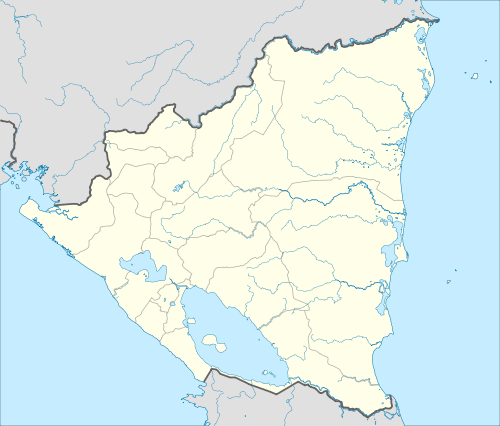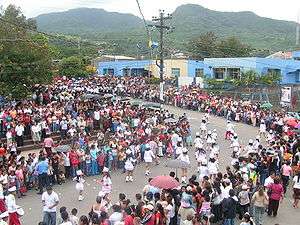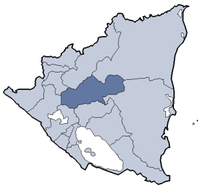Matagalpa, Nicaragua
| Matagalpa, Nicaragua San Pedro de Matagalpa | |||
|---|---|---|---|
| Municipality | |||
|
Matagalpa's Cathedral | |||
| |||
 Matagalpa, Nicaragua Location in Nicaragua | |||
| Coordinates: 12°55′N 85°55′W / 12.917°N 85.917°W | |||
| Country |
| ||
| Department | Matagalpa Department | ||
| Area | |||
| • Municipality | 247.36 sq mi (640.65 km2) | ||
| Population (2012) | |||
| • Municipality | 542,000 | ||
| • Metro | 150,643 (4th Nicaragua) | ||
| Climate | Aw | ||
Matagalpa (Spanish pronunciation: [mataˈɣalpa]) is a city in Nicaragua, the capital of the department of Matagalpa. The city has a population of 150,643 (2012 census), while the population of the department is more than 542,000. Matagalpa is Nicaragua's fourth largest city, the largest in the country's interior and one of the most commercially active outside of Managua. Matagalpa is the second most important city in Nicaragua and is known as the "Pearl of the North" and "Land of Eternal Spring."
Origin of the name
According to Jeronimo Perez, a historian who visited this area in 1855–1856 the name Matagalpa means Cabeza Principal (Main Head) or Pueblo Grande (Big Town) from the Matagalpa Indian language words: Maika=Head, Calpul* Town- But according to the Matagalpan linguist father Guillermo Kiene, a Catholic priest and missionary who lived from 1898 to 1959, the word Matagalpa comes from the Sumo language, and means "let's go where the rocks are."
There have been other descriptions of the word Matagalpa: -Here next to the water, and -Among Mountains ( "Aqui junto al agua" y "Entre Montañas"). These descriptions are believed to be related to the geographic location of the city, which is next to the Grand River of Matagalpa, and also beautifully surrounded by mountains.
Pre-colonial history
Matagalpa was originally an indigenous village. The Matagalpa Indians had their own language, which has been extinct since 1875. A document from the year 1855 with 97 words and phrases from the Matagalpa language can be found in the Daniel G. Brinton section of the American Philosophical Library in Philadelphia.
The Matagalpa made ceramics of a style known as "Ceramica Negra" and "Naranja Segovia", they also built stone statues representing their chieftain and warriors. They were feared by the Spanish because they were very brave and effective with their bows and other arms. It took 300 years for the Spanish to submit them, even at the time of Nicaragua Independence in 1821 there were many Matagalpa Indians free in the central mountains of Nicaragua. In 1856 they were decisive to defeat William Walker's filibusteers in the Battle of San Jacinto on 14 September 1856, where a column of 60 Matagalpa Indians with bow and arrows fought at the side of Nicaraguan Patriots winning that battle, which marked the end of Walker adventure in Nicaragua. That quest has been recognized by historians and archaeologists, and there is a popular movement to declare the Matagalpa Indians as National Heroes by the Congress of the Republic next month of September 2011.
Post-colonial history

Matagalpa was an existing Indian town when the first Spaniards came to this region by 1528 during an attempt to find a water passage to the "Northern Sea", the Caribbean. (Nicaragua's Spanish colonization originated from the direction of the Pacific Ocean, which was called the Southern Sea by the Spaniards.
Matagalpa is located in the continental divide between the Pacific Ocean and the Caribbean Sea. Many stories are preserved from colonial times about the British-controlled Mosquito Coast, and the Spanish-colonized Pacific area.
Gold was discovered around Matagalpa by 1840. Along with many Spaniards and Mestizos, it attracted German, American and British immigrants. Two of the better known immigrants of this period were Ludwig Elster (from Hannover) and his wife Katharina Braun (from Schwarzwald, Germany Black Forest) who planted the first coffee trees in the area, the beans from which quickly went to market in Germany. Coffee agriculture attracted more than 120 European immigrants, many of whom married Matagalpan women, and many of their descendants still live in the area.
In 1923 some Danish immigrants also came to Matagalpa, and settled in the highlands as well. Most of the Danish families went back to Denmark. Three families stayed: the Gröns, the Möllers, and the Petersens.
Matagalpa was also the city of refuge for many Nicaraguans escaping the invasion of Tennessean filibuster William Walker who took over much of the country and government in 1856. In Matagalpa the patriots organized the Ejército del Setentrión ("Army of the North"), which fought in and won the Battle of San Jacinto, assisted by 60 Matagalpa Indians, on 14 September 1856, helping to end Walker's rule.
Matagalpa was also the birthplace of Nazario Vega, Governor and builder of the Cathedral; Bartolomé Martínez, President of Nicaragua, 1923–24; and Carlos Fonseca Amador, founder of the Sandinista Front in 1961.
Currently the department of Matagalpa is the second most populous in Nicaragua after the national capital (Managua), and the most diversified in production. Over the past few years Matagalpa has experienced a large influx of migrants (mainly peasants) from other departments, causing stress on infrastructure and the environment.
Matagalpa has a beautiful panoramic highway that starts in the city of Matagalpa and extends 30 kilometres (19 miles) to the city of Jinotega. Scenic views extend up to 140 kilometres (87 miles) away, to the volcanic range near the Pacific coast.
Many historians, archeologists, botanists and ethnologists have arrived in recent years to do research in this region. American and European descendants of the first settlers are also returning to visit the historical homes of their ancestors.
Economy
Matagalpa is a very well diversified province. It produces and exports beef, cheese, coffee, cacao, onions, tomatoes and mixed fruits and vegetables. For local consumption it produces flowers, wood, corn, beans, fruits (oranges, grapefruits, bananas, plantains) and many kinds of vegetables such as broccoli, and cauliflower.
Matagalpa is known for its good coffee, its cattle, milk products, vegetables, flowers and mountains popular with ecotourists. It is the location of such storied mountain tourist resorts as Aranjuez, Santa Maria de Ostuma, and Selva Negra Mountain Resort.
A large part of the economy in Matagalpa depends on eco-tourism. Nature hikes, walks, and excursions are very common throughout Matagalpa, and the northern region on Nicaragua. One of the most recognized eco-tourism sites is Selva Negra Wildlife Refuge, with over 300 acres (121 ha) of land dedicated to the conservation of the area's diverse flora and fauna.
Recently a large water project has been completed. A potable water system and a new waste water treatment facility were funded and built by the German government.
A new extension of the paved highway Managua-Sebaco-Matagalpa-Jinotega has been completed.
Climate
Matagalpa, along with nearby Jinotega, enjoy "eternal spring" or all year, spring-like weather. Matagalpa lies more than 700 m (2,297 ft) above sea level with the average temperature ranging from 26 to 28 °C (79 to 82 °F)., and relative humidity between 75% to 85%. Average rainfall is 1,200 to 1,900 mm (47 to 75 in).
Gallery
- Main Street to Parque Morazan and Cathedral
 Child on way to school through Parque Morazan
Child on way to school through Parque Morazan View from second floor of house near Parque Morazan and the Cathedral
View from second floor of house near Parque Morazan and the Cathedral Backyard in Apante, Matagalpa, near overlook of downtown
Backyard in Apante, Matagalpa, near overlook of downtown Overlook of downtown from Matagalpa-Jinotega highway during the dry season
Overlook of downtown from Matagalpa-Jinotega highway during the dry season 2007 Independence Day parade
2007 Independence Day parade- 2007 Independence Day parade
 Home in Matagalpa
Home in Matagalpa- Home in Matagalpa
- Home in Matagalpa
 Main Police Station in Matagalpa
Main Police Station in Matagalpa
| Wikimedia Commons has media related to Matagalpa, Nicaragua. |
Famous People
- Byron Rojas, boxer
International relations
Twin towns – Sister cities
Matagalpa is twinned with:
|
|
References
- ↑ "Partneri- ja kummikaupungit (Partnership and twinning cities)". Oulun kaupunki (City of Oulu) (in Finnish). Retrieved 2013-07-27.
External links
 Matagalpa travel guide from Wikivoyage
Matagalpa travel guide from Wikivoyage
Coordinates: 12°55′N 85°55′W / 12.917°N 85.917°W


